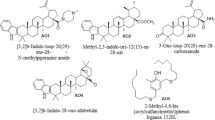Abstract
The behavior of phenolic antioxidants is studied in a partitioned medium, composed of linoleic acid dispersed in an aqueous phase. Their efficiency is measured by the diene production during oxidation, induced by Fe (II)/ascorbic acid at 30°C. With a linoleic acid/Fe2+ molar ratio of 10 and a Fe2+/ascorbic acid molar ratio of 23, a steady-state propagation rate is reached after 1 h for up to 15 h. The antioxidants cannot avoid the early dienes (30–40% of total dienes), resulting from the inducing reactions; however, they can stop all the dienes produced during propagation reactions by acting on ROO. The inhibition values reveal a great difference between the antioxidants, depending on their structure (number of hydroxyl groups or chelating sites) and on their polarity, confirming the “polar paradox”. Thus, α-tocopherol, butylated hydroxytoluene, butylated hydroxyanisole, and isoeugenol appear to be the best antioxidants, but rosmarinic and caffeic acids, generally potent antioxidants, present a weak efficiency. Surprisingly, in such a metal-induced system, the chelator activity seems to play a minor role.
Similar content being viewed by others
References
Berset, C., and M.-E. Cuvelier, Methods of Estimating the Degree of Lipid Oxidation and of Measuring Antioxidizing Power, Sci. Aliments 16:219–245 (1996).
Frankel, E., In Search of Better Methods to Evaluate Natural Antioxidants and Oxidative Stability in Food Lipids, Trends Food Sci. Technol. 4:220–225 (1993).
Frankel, E., S.W. Huang, J. Kanner, and J.B. German, Interfacial Phenomena in the Evaluation of Antioxidants: Bulk Oils vs. Emulsions, J. Agric. Food Chem. 42:1054–1059 (1994).
Porter, W., E.D. Black, and A.M. Drolet, Use of Polyamide Oxidative Fluorescence Test on Lipid Emulsions: Contrast in Relative Effectiveness of Antioxidants in Bulk versus Dispersed Systems, 37:615–624 (1989).
Kansci, G., C. Genot, A. Meynier, and G. Gandemer, The Antioxidant Activity of Carnosine and Its Consequences on the Volatile Profiles of Liposomes During Iron/Ascorbate Induced Phospholipid Oxidation, Food Chem. 60:165–175 (1997).
Aruoma, O., P. Evans, H. Kaur, L. Sutcliffe, and B. Halliwell, An Evaluation of the Antioxidant and Potential Pro-Oxidant Properties of Food Additives and of Trolox C, Vitamin E and Probucol, Free Radical Res. Commun. 10:143–167 (1990).
Fukuzawa, K., T. Seko, K. Mimami, and J. Terao, Dynamics of Iron-Ascorbate-Induced Lipid Peroxidation in Charged and Uncharged Phospholipid Vesicles, Lipids 28:497–503 (1993).
Bondet, V., M.-E. Cuvelier, and C. Berset, Behavior of Phenolic Antioxidants in a Partitioned Medium: Focus on Linoleic Acid Peroxidation Induced by Iron/Ascorbic Acid System, J. Am. Oil Chem. Soc. 77:813–818 (2000).
Cuvelier, M.-E., C. Berset, and H. Richard, Use of a New Test for Determining Comparative Antioxidative Activity of Butylated Hydroxyanisole, Butytated Hydroxytoluene, α-and γ-Tocopherols and Extracts from Rosemary and Sage, Sci. Aliments 10:797–806 (1990).
Cuvelier, M.-E., H. Richard, and C. Berset, Comparison of the Antioxidative Activity of Some Acid Phenols: Structure-Activity Relationship, Biosci. Biotechnol. Biochem. 56:324–325 (1992).
Peyrat-Maillard, M.-N., M.-E. Cuvelier, V. Bondet, A. Bocco, and C. Berset, Antioxidant Activity of Phenolic Compounds: Behavior in Different Model Systems and Synergistic Effects, in Abstracts of the 89th AOCS Annual Meeting and Expo, Chicago, 1998.
Chen, X., and D. Ahn, Antioxidant Activities of Six Natural Phenolics Against Lipid Oxidation Induced by Fe2+ or Ultraviolet Light, J. Am. Oil Chem. Soc. 75:1716–1721 (1998).
Foti, M., M. Piattelli, M. Tiziana Baratta, and G. Ruberto, Flavonoids, Coumarins, and Cinnamic Acids as Antioxidants in a Micellar System, Structure-Activity Relationship, J. Agric. Food Chem. 44:497–501 (1996).
Pokorny, J., Major Factors Affecting the Autoxidation of Lipids, in Autoxidation of Unsaturated Lipids, edited by H. Chan, Academic Press, London, 1987, pp. 141–206.
Pratt, D.E., and J.B.F. Hudson, Natural Antioxidants Not Exploited Commercially, in Food Antioxidants, edited by J. Hudson, Elsevier Applied Science, London, 1990, pp. 171–192.
Author information
Authors and Affiliations
Corresponding author
About this article
Cite this article
Cuvelier, ME., Bondet, V. & Berset, C. Behavior of phenolic antioxidants in a partitioned medium: structure—Activity relationship. J Amer Oil Chem Soc 77, 819–824 (2000). https://doi.org/10.1007/s11746-000-0131-4
Received:
Accepted:
Issue Date:
DOI: https://doi.org/10.1007/s11746-000-0131-4




